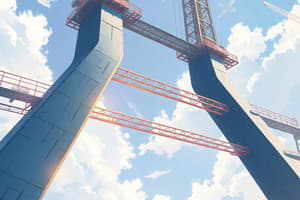Podcast
Questions and Answers
What is the primary purpose of pre-stressing a structure?
What is the primary purpose of pre-stressing a structure?
- To reduce material costs
- To increase its load-bearing capacity (correct)
- To simplify construction processes
- To enhance visual appeal
What happens to the steel tendons in a pre-stressing system?
What happens to the steel tendons in a pre-stressing system?
- They are stretched and kept in tension (correct)
- They are embedded in plastic sheaths
- They remain loose and flexible
- They are primarily used for decoration
What differentiates pre-tensioned tendons from post-tensioned tendons?
What differentiates pre-tensioned tendons from post-tensioned tendons?
- Their placement within the structure
- The timing of when they're tensioned (correct)
- Their strength and diameter
- The type of materials used
Which statement best describes bonded tendons?
Which statement best describes bonded tendons?
How do pre-stressed tendons assist in load balancing?
How do pre-stressed tendons assist in load balancing?
What is a significant factor that can lead to losses in pre-stressing?
What is a significant factor that can lead to losses in pre-stressing?
What characteristic does concrete have that is crucial for its role in pre-stressing?
What characteristic does concrete have that is crucial for its role in pre-stressing?
What type of slab system is designed to be supported by walls or narrow beams on two sides?
What type of slab system is designed to be supported by walls or narrow beams on two sides?
What is a primary advantage of prestressed concrete compared to regular concrete?
What is a primary advantage of prestressed concrete compared to regular concrete?
Which type of prestressing involves stretching tendons before the concrete is poured?
Which type of prestressing involves stretching tendons before the concrete is poured?
What is the main reason for using high-strength materials in prestressing?
What is the main reason for using high-strength materials in prestressing?
What do bonded tendons in prestressed concrete do?
What do bonded tendons in prestressed concrete do?
What does load balancing in prestressing help to prevent?
What does load balancing in prestressing help to prevent?
Which type of prestressing is commonly used in high-rise buildings?
Which type of prestressing is commonly used in high-rise buildings?
What are immediate losses in prestressing primarily related to?
What are immediate losses in prestressing primarily related to?
Which structure is typically a determinate structure?
Which structure is typically a determinate structure?
What is a significant characteristic of flat slabs and flat plates?
What is a significant characteristic of flat slabs and flat plates?
What is typically the compressive strength of prestressed concrete?
What is typically the compressive strength of prestressed concrete?
What is one of the main objectives of pre-stressing concrete?
What is one of the main objectives of pre-stressing concrete?
Which type of structure is described as easier to calculate forces?
Which type of structure is described as easier to calculate forces?
What is a key characteristic of flat slabs and flat plates?
What is a key characteristic of flat slabs and flat plates?
What is the primary function of tendons in the pre-stressing process?
What is the primary function of tendons in the pre-stressing process?
Which statement correctly describes a benefit of using prestressed concrete?
Which statement correctly describes a benefit of using prestressed concrete?
What primarily defines post-tensioned pre-stressing?
What primarily defines post-tensioned pre-stressing?
Which characteristic is true for unbonded tendons in pre-stressing?
Which characteristic is true for unbonded tendons in pre-stressing?
What type of pre-stressing results in tendons that can move independently?
What type of pre-stressing results in tendons that can move independently?
What is a potential cause of losses in pre-stressing?
What is a potential cause of losses in pre-stressing?
Which of the following is a consequence of immediate pre-stress losses?
Which of the following is a consequence of immediate pre-stress losses?
What is the role of high-tensile wires in pre-stressing?
What is the role of high-tensile wires in pre-stressing?
Which slab system is specifically characterized by support only on two sides?
Which slab system is specifically characterized by support only on two sides?
What is the role of steel tendons in prestressed concrete?
What is the role of steel tendons in prestressed concrete?
In which scenarios is prestressed concrete most commonly applied?
In which scenarios is prestressed concrete most commonly applied?
What is the primary advantage of using pre-tensioned tendons?
What is the primary advantage of using pre-tensioned tendons?
How does pre-stressing contribute to preventing sagging in structures?
How does pre-stressing contribute to preventing sagging in structures?
How does pre-stressing contribute to the durability of a structure?
How does pre-stressing contribute to the durability of a structure?
What defines a bonded tendon in a pre-stressing system?
What defines a bonded tendon in a pre-stressing system?
Which of the following best describes the concept of load balancing in pre-stressed structures?
Which of the following best describes the concept of load balancing in pre-stressed structures?
What is an advantage of using stronger materials in pre-stressing?
What is an advantage of using stronger materials in pre-stressing?
Flashcards
Pre-Stressing
Pre-Stressing
Applying force to a structure before it's loaded, making it stronger and more resistant to bending or breaking.
Pre-Tensioned
Pre-Tensioned
Tendons are stretched before the concrete is poured.
Post-Tensioned
Post-Tensioned
Tendons are stretched after the concrete has hardened.
Strand
Strand
Signup and view all the flashcards
Tendon
Tendon
Signup and view all the flashcards
Cable
Cable
Signup and view all the flashcards
Bonded Tendons
Bonded Tendons
Signup and view all the flashcards
Unbonded Tendons
Unbonded Tendons
Signup and view all the flashcards
Load Balancing
Load Balancing
Signup and view all the flashcards
Concrete Strength
Concrete Strength
Signup and view all the flashcards
Steel Strength
Steel Strength
Signup and view all the flashcards
One-Way Slab
One-Way Slab
Signup and view all the flashcards
Prevent Cracking
Prevent Cracking
Signup and view all the flashcards
Control Deflection
Control Deflection
Signup and view all the flashcards
High-Tensile Wires
High-Tensile Wires
Signup and view all the flashcards
Pre-Stressing
Pre-Stressing
Signup and view all the flashcards
Objectives of Pre-Stressing
Objectives of Pre-Stressing
Signup and view all the flashcards
Pre-Tensioned Pre-Stressing
Pre-Tensioned Pre-Stressing
Signup and view all the flashcards
Post-Tensioned Pre-Stressing
Post-Tensioned Pre-Stressing
Signup and view all the flashcards
Bonded Tendons
Bonded Tendons
Signup and view all the flashcards
Unbonded Tendons
Unbonded Tendons
Signup and view all the flashcards
Load Balancing
Load Balancing
Signup and view all the flashcards
Concrete Strength (Pre-Stress)
Concrete Strength (Pre-Stress)
Signup and view all the flashcards
Steel Strength (Pre-Stress)
Steel Strength (Pre-Stress)
Signup and view all the flashcards
Pre-stress Losses
Pre-stress Losses
Signup and view all the flashcards
Two-Way Slab
Two-Way Slab
Signup and view all the flashcards
Flat Slab/Plate
Flat Slab/Plate
Signup and view all the flashcards
Pre-stressing
Pre-stressing
Signup and view all the flashcards
Pre-tensioned Pre-Stressing
Pre-tensioned Pre-Stressing
Signup and view all the flashcards
Post-tensioned Pre-Stressing
Post-tensioned Pre-Stressing
Signup and view all the flashcards
Two-Way Slab
Two-Way Slab
Signup and view all the flashcards
Flat Slab/Plate
Flat Slab/Plate
Signup and view all the flashcards
Load Balancing (Pre-Stress)
Load Balancing (Pre-Stress)
Signup and view all the flashcards
Pre-stress Losses
Pre-stress Losses
Signup and view all the flashcards
Concrete Strength (Pre-Stress)
Concrete Strength (Pre-Stress)
Signup and view all the flashcards
Steel Strength (Pre-Stress)
Steel Strength (Pre-Stress)
Signup and view all the flashcards
Objectives of Pre-Stressing
Objectives of Pre-Stressing
Signup and view all the flashcards
Pre-Stressing
Pre-Stressing
Signup and view all the flashcards
Objectives of Pre-Stressing
Objectives of Pre-Stressing
Signup and view all the flashcards
High-Tensile Wires
High-Tensile Wires
Signup and view all the flashcards
Concrete Compression
Concrete Compression
Signup and view all the flashcards
Pre-Tensioned
Pre-Tensioned
Signup and view all the flashcards
Post-Tensioned
Post-Tensioned
Signup and view all the flashcards
Strand
Strand
Signup and view all the flashcards
Tendon
Tendon
Signup and view all the flashcards
Cable
Cable
Signup and view all the flashcards
Bonded Tendons
Bonded Tendons
Signup and view all the flashcards
Unbonded Tendons
Unbonded Tendons
Signup and view all the flashcards
Load Balancing
Load Balancing
Signup and view all the flashcards
Concrete Strength
Concrete Strength
Signup and view all the flashcards
Steel Strength
Steel Strength
Signup and view all the flashcards
One-Way Slab
One-Way Slab
Signup and view all the flashcards
Study Notes
Pre-Stressing: Definition and Objectives
-
Definition: Applying forces to a structure before it carries any load. This makes the structure stronger and more resistant to breaking or bending. Think stretching a rubber band before use.
-
Objectives:
- Prevent cracking: Reduces or eliminates cracks in concrete.
- Control deflection: Prevents excessive bending under load.
- Use stronger materials: Allows use of stronger steel and concrete to ensure longevity and load-bearing capacity.
Pre-Stressing: Basic Concept
-
Components: High-tensile steel wires (tendons) are stretched inside the concrete.
-
Mechanism: The stretched tendons compress the concrete, making it stronger and less prone to cracking. The steel is under tension; the concrete, under compression.
Pre-Stressing: Terminology
-
Strand: A bundle of high-strength wires.
-
Tendon: A single strand or bundle of strands.
-
Cable: A group of tendons.
-
Types:
- Pre-tensioned: Tendons stretched before concrete is poured.
- Post-tensioned: Tendons stretched after concrete has hardened (more common).
Pre-Stressing: Types of Tendons
- Bonded tendons: Tendons glued to concrete, acting as one unit.
- Unbonded tendons: Tendons in plastic sheaths, allowing for movement.
Pre-Stressing: Load Balancing Concepts
- Load balancing: Tendons pull upwards, balancing the weight of the structure and reducing bending.
Pre-Stressing: Material Properties
- Concrete: High compressive strength, but susceptible to cracking under tension.
- Steel: High tensile strength (ability to stretch).
Pre-Stressing: Losses
- Losses in pre-stress tension occur over time due to factors like friction and concrete shrinkage. Engineers plan for these.
Pre-Stressing: Slab Systems
- Slab types:
- One-way slab: Supported by walls or beams on two sides.
- Two-way slab: Supported on four sides (often square).
- Flat slabs/plates: No beams, flat ceilings (common for multistory buildings).
Pre-Stressing: Key Considerations
- Stronger materials: Utilizing high-strength concrete and steel is essential.
- Losses: Account for time-dependent losses to maintain strength over time.
Pre-Stressing: Serviceability Improvements
- Reduced cracking: Less susceptible to cracking and bending.
- Thinner slabs: Allows creation of longer spans with thinner sections. (70% of regular concrete).
Pre-Stressing: Structure Types
- Determinate structures: Easily calculated force structures.
- Indeterminate structures: Complex structures with multiple supports; more strength and less predictable forces.
Pre-Stressing: Key Takeaways
- Pre-stressing strengthens concrete by placing tendons under tension.
- Load balancing prevents sagging.
- Material properties and losses must be considered.
- Various slab systems (one-way, two-way, flat slabs) exist.
- Pre-stressing excels in bridges, buildings, floors, for long spans, and high durability.
Studying That Suits You
Use AI to generate personalized quizzes and flashcards to suit your learning preferences.



